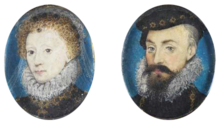
Elizabeth I was Queen of England and Ireland from 17 November 1558 until her death in 1603. Elizabeth was the last monarch of the House of Tudor and is sometimes referred to as the "Virgin Queen".

The House of Tudor was a dynasty of largely Welsh and English origin that held the English throne from 1485 to 1603. They descended from the Tudors of Penmynydd and Catherine of Valois. The Tudor monarchs ruled the Kingdom of England and its realms, including their ancestral Wales and the Lordship of Ireland for 118 years with five monarchs: Henry VII, Henry VIII, Edward VI, Mary I and Elizabeth I. The Tudors succeeded the House of Plantagenet as rulers of the Kingdom of England, and were succeeded by the House of Stuart. The first Tudor monarch, Henry VII of England, descended through his mother from a legitimised branch of the English royal House of Lancaster, a cadet house of the Plantagenets. The Tudor family rose to power and started the Tudor period in the wake of the Wars of the Roses (1455–1487), which left the main House of Lancaster extinct in the male line.
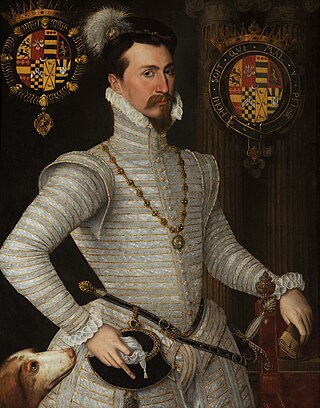
Robert Dudley, 1st Earl of Leicester, was an English statesman and the favourite of Elizabeth I from her accession until his death. He was a suitor for the queen's hand for many years.
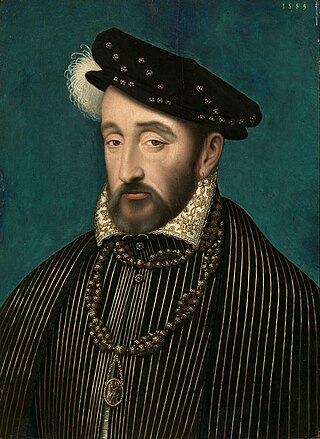
Henry II was King of France from 1547 until his death in 1559. The second son of Francis I and Duchess Claude of Brittany, he became Dauphin of France upon the death of his elder brother Francis in 1536.

Elizabeth is a 1998 British biographical period drama film directed by Shekhar Kapur and written by Michael Hirst. It stars Cate Blanchett in the title role of Elizabeth I of England, with Geoffrey Rush, Christopher Eccleston, Joseph Fiennes, John Gielgud, and Richard Attenborough in supporting roles. The film is based on the early years of Elizabeth's reign, where she is elevated to the throne after the death of her half-sister Mary I, who had imprisoned her. As she establishes herself on the throne, she faces plots and threats to take her down.
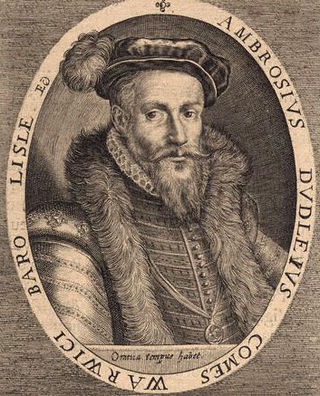
Ambrose Dudley, 3rd Earl of Warwick, KG was an English nobleman and general, and an elder brother of Queen Elizabeth I's favourite, Robert Dudley, Earl of Leicester. Their father was John Dudley, Duke of Northumberland, who led the English government from 1550–1553 under King Edward VI and unsuccessfully tried to establish Lady Jane Grey on the English throne after the King's death in July 1553. For his participation in this venture Ambrose Dudley was imprisoned in the Tower of London and condemned to death. Reprieved, his rehabilitation came after he fought for King Philip in the Battle of St. Quentin.

Lady Mary Keyes was the youngest daughter of Henry Grey, 1st Duke of Suffolk, and Frances Brandon, and through her mother had a claim on the crown of England.
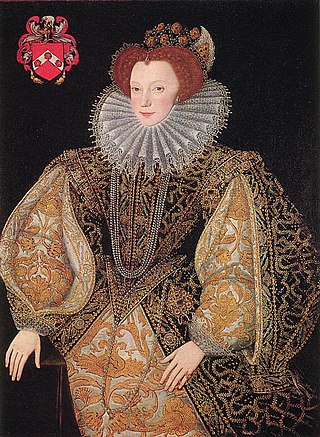
Lettice Knollys, Countess of Essex and Countess of Leicester, was an English noblewoman and mother to the courtiers Robert Devereux, 2nd Earl of Essex, and Lady Penelope Rich. By her second marriage to Elizabeth I's favourite, Robert Dudley, Earl of Leicester, she incurred the Queen's unrelenting displeasure.

Amy, Lady Dudley was the first wife of Robert Dudley, Earl of Leicester, favourite of Elizabeth I of England. She is primarily known for her death by falling down a flight of stairs, the circumstances of which have often been regarded as suspicious. Amy Robsart was the only child of a substantial Norfolk gentleman. In the vernacular of the day, her name was spelled as Amye Duddley.
Douglas, Lady Sheffield, was an English noblewoman, the lover of Robert Dudley, 1st Earl of Leicester and mother by him of explorer/cartographer Sir Robert Dudley, an illegitimate son.

Catherine Carey, after her marriage Catherine Knollys and later known as both Lady Knollys and Dame Catherine Knollys,, was chief Lady of the Bedchamber to Queen Elizabeth I, who was her first cousin.

Frances Grey, Duchess of Suffolk, was an English noblewoman. She was the second child and eldest daughter of King Henry VIII's younger sister, Princess Mary, and Charles Brandon, 1st Duke of Suffolk. She was the mother of Lady Jane Grey, de facto Queen of England and Ireland for nine days, as well as Lady Katherine Grey and Lady Mary Grey.

Henry Norris, 1st Baron Norreys of Rycote in Oxfordshire, was an English politician and diplomat, who belonged to an old Berkshire family, many members of which had held positions at the English court.

Katherine Ashley, also known as Kat Ashley or Astley, was the first close friend, governess, and Lady of the Bedchamber to Queen Elizabeth I of England. She was the aunt of Katherine Champernowne, who was the mother of Sir Humphrey Gilbert from her first marriage and Walter Raleigh by her second marriage.
Margaret Stanley, Countess of Derby was the only surviving daughter of Henry Clifford, 2nd Earl of Cumberland and Lady Eleanor Brandon. Her maternal grandparents were Charles Brandon, 1st Duke of Suffolk and Mary Tudor, Queen of France. Mary was the third daughter of King Henry VII of England and Elizabeth of York.
A marriage of state is a diplomatic marriage or union between two members of different nation-states or internally, between two power blocs, usually in authoritarian societies and is a practice which dates back into ancient times, as far back as early Grecian cultures in western society, and of similar antiquity in other civilizations. The fable of Helen of Troy may be the best known classical tale reporting an incidence of surrendering a female member of a ruling line to gain peace or shore up alliances of state between nation-states headed by small oligarchies or acknowledged royalty.

Charles II Francis of Austria was an Archduke of Austria and a ruler of Inner Austria from 1564. He was a member of the House of Habsburg.
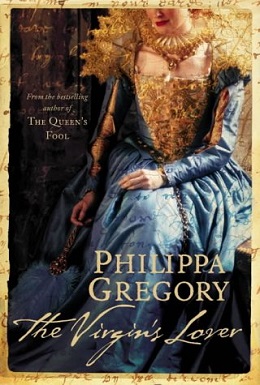
The Virgin's Lover is a historical novel written by British author Philippa Gregory. It belongs to her series of Tudor novels, including The Constant Princess, The Other Boleyn Girl, The Boleyn Inheritance, and The Queen's Fool.
Joan Vaux, Lady Guildford, also known as Mother Guildford, was an English courtier who was the Lady Governess to the Princesses Margaret Tudor and Mary Tudor. She accompanied Mary Tudor to France when she married King Louis XII in 1514.
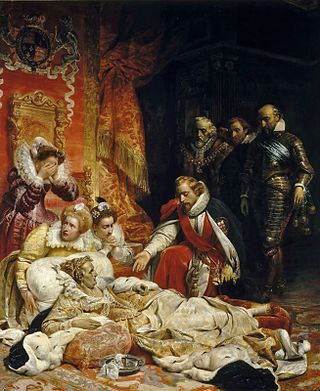
The succession to the childless Elizabeth I was an open question from her accession in 1558 to her death in 1603, when the crown passed to James VI of Scotland. While the accession of James went smoothly, the succession had been the subject of much debate for decades. It also, in some scholarly views, was a major political factor of the entire reign, if not so voiced. Separate aspects have acquired their own nomenclature: the "Norfolk conspiracy", Patrick Collinson's "Elizabethan exclusion crisis", and the "Secret Correspondence".
